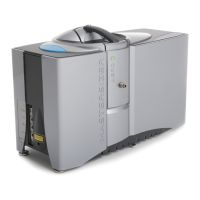Viewing measurement results Chapter 5
Mastersizer 3000 Page 5-19
The sphere of equivalent volume would have a diameter centred on:
with a spread from 20 to 60μm.
It is interesting to compare this with other techniques. Sieving would pass the par-
ticles through a 20μm aperture and classify them as 20μm. Sedimentation would
give a result related to the total surface area, in this case reporting a diameter of
around 40μm.
Derived distribution parameters
The particle size distribution reported by the software is expressed in a set of size
classes which are optimized to match the detector geometry and optical configura-
tion, giving the best resolution. All parameters are derived from this fundamental
distribution.
Distribution parameters and derived diameters are calculated from the fundamen-
tal distribution using the summation of the contributions from each size band. In
performing this calculation the representative diameter for each band is taken to be
the geometric mean of the size band limits:
This number will be slightly different to the arithmetic mean:
For example, the size band 404.21 - 492.47 microns has a geometric mean of 446.16
microns and an arithmetic mean of 448.34 microns. In most cases the difference is
small but the geometric mean is chosen in these calculations as more appropriate to
the logarithmic spacing of the fundamental size classes.
The same principle of calculation applies to the distribution statistics standard devi-
ation, skewness and kurtosis, as shown below:
standard deviation
d
il–
d
i
+
2
--------------------
X
i
d
i
d–
2
X
i
---------------------------------- DK 2+ K[,]
2
DK 1+ K[,]
2
+==

